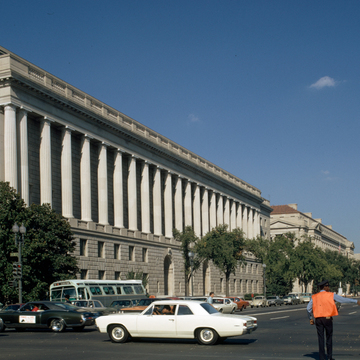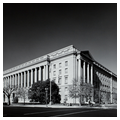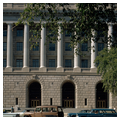The Office of the Supervising Architect commenced design work on the Internal Revenue Service Building before the Federal Triangle group had been planned. The reaction among private architects to the single building project accelerated the move toward a larger scheme. The resulting treatment of the Internal Revenue Service structure reflects a peculiar ordering of elements within the larger plan. Department headquarters were to be accorded monumental buildings “of the first class,” while bureaus, of which the Internal Revenue Service was the only example in the Triangle, were to be housed in subordinate structures. As the Internal Revenue Service building became absorbed into the Federal Triangle group plan, its design became dramatically scaled back and shorn of sculptural detail originally planned.
As completed, the Internal Revenue Service Building presents a simple Doric colonnaded elevation on the Constitution Avenue side. On the other sides, horizontal planes were divided between a two-story rusticated base, a middle section marked with long rows of fluted Doric pilasters rising from the third to the fifth floors, and an attic story set behind a balcony. Because the survival of the Old Post Office prevented the completion of the Internal Revenue Service Building, the latter exhibits raw edges of brick and limestone on the Pennsylvania Avenue and 12th Street elevations.
The history of the Internal Revenue Service Building illustrates the scant respect architects in private practice accorded Louis A. Simon and the Office of the Supervising Architect of the Treasury Department. An employee of the office from 1896, Simon served as its chief architect from 1915 to 1934 under James A. Wetmore, who held the position of acting supervising architect. After Wetmore's retirement in 1934, Simon was appointed Supervising Architect. Simon maintained a career-long cooperative attitude toward private practitioners, but in return, few regarded him as their creative equal.
The supporters of the Federal Triangle group no doubt included many who possessed a genuine desire to see a world-class architectural ensemble develop in such a key location. Other architects seized upon the project to further their contention that government architects were less able as designers than private practitioners. In arguing for a comprehensive Federal Triangle scheme, several private architects accused Simon's office of being capable only of “parking” the buildings on the triangle site, rather than grouping them. After the Internal Revenue Service was forced into a relatively spartan design in the overall group plan, private architects singled out the building as the least inspiring component in the complex.








